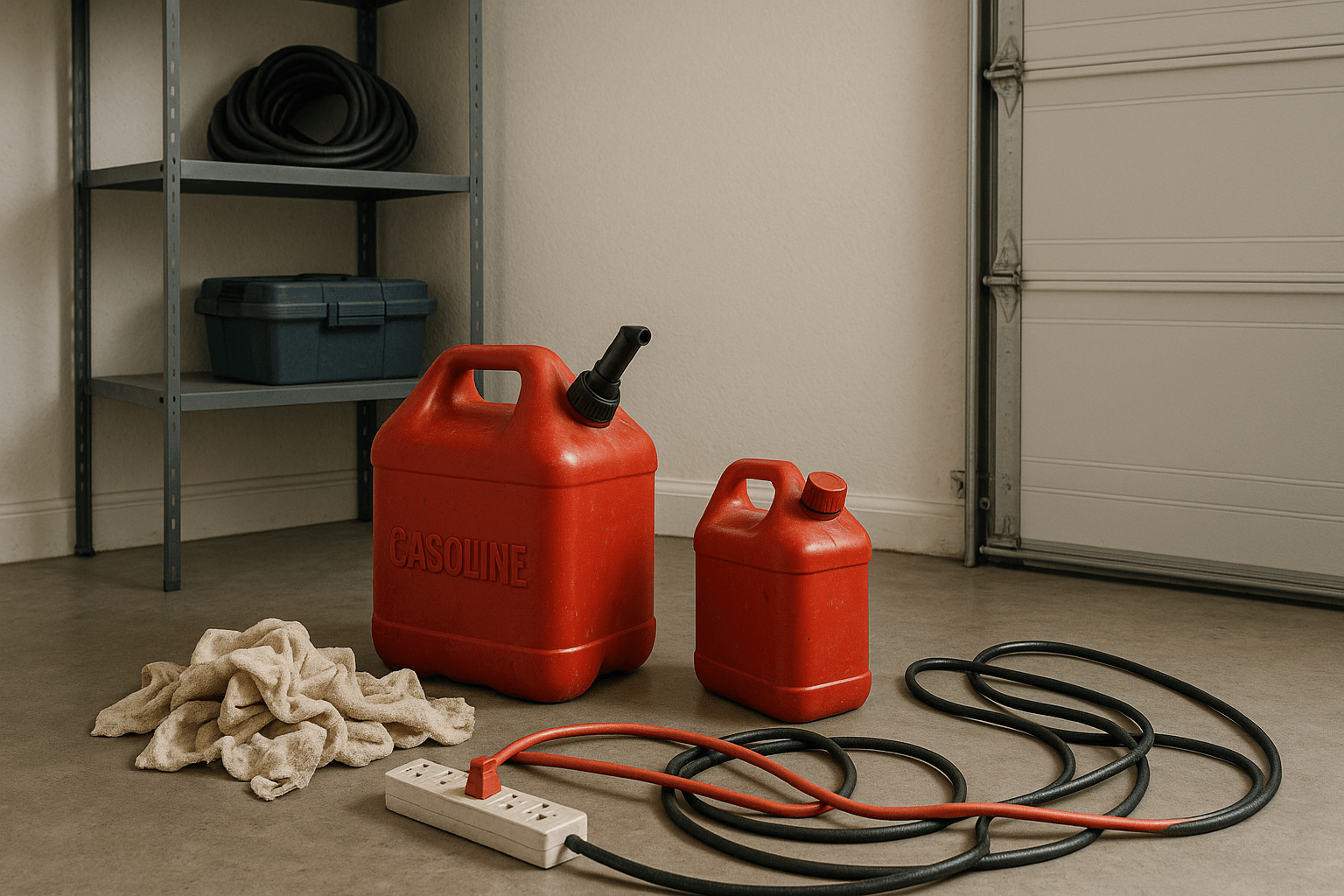
Garage Fire Hazards and How to Eliminate Them
Key Takeaways
1. Most garage fire hazards originate from everyday risks, including batteries, flammable liquids, oily rags, hot ashes, and weak barriers.
2. Safety improves with a fire-rated garage door, intact drywall, a heat alarm, proper storage, and dedicated circuits.
3. Raynor Door Authority supports homeowners with expert fire-rated garage door installation, steady maintenance, and clear guidance for a safer garage.
The Real Causes of Garage Fire Hazards (And How to Prevent Them)
Your garage door affects how smoke, heat, and people move during an incident. A door that seals tight, reverses on light contact, closes on time, and opens during a power cut can slow the spread and protect your exit. Here are the exact causes:
1. Lithium-ion Tool Batteries
A lithium-ion battery pack holds a significant amount of energy in a compact space. Incorrect chargers, off-brand batteries, impact damage, or trapped heat can cause a cell to enter thermal runaway, and a single failing cell can trigger the rest.
- Keep the charging table outside the garage door travel path so the photo eyes detect the beam and the auto-reverse stays active.
- Use a garage door opener with a timer-to-close so the door does not sit open and feed airflow during a small fire.
- Add battery backup to the opener so the garage door opens for a fast exit if the power fails.
Raynor Door Authority sets safe opener limits and force and installs battery-backup openers for your garage that keep the exit working during an outage.
2. Flammable Liquids
It’s the vapor that ignites first, not the liquid. Many vapors sink and drift along the floor toward burners, space heaters, or tool sparks.
Fit a fresh garage door bottom seal (astragal) and intact side and header weatherstrips so the garage door closes flush at the floor. Keep fuel cans away from tracks, springs, and opener wiring to avoid impact or sparks.
Raynor Door Authority helps replace worn seals, balances the door to land flat, and tunes travel to stop cleanly on the floor.
3. Oily Rags
Place rag cans and project carts outside the arc of the garage door and away from photo eyes. Clean the sensor lenses and test auto-reverse so the garage door backs off at the first touch.
Raynor Door Authority helps by aligning photo eyes, setting safe force and travel, and documenting the 2×4 reversal test so your garage door responds predictably.
4. Extension Cords and Power Strips Used for the Opener
An opener draws a sharp inrush of current every time it starts. Extension cords and power strips are not built for that duty. Draped cords rub on the trolley and tracks. Vibration loosens plug blades.
A coiled cord on a hook acts like a heating element. Dust collects on warm plugs and outlets, becoming easy fuel.
How to fix it: Install a permanent ceiling receptacle near the opener and plug the opener in directly. Use a dedicated 15- or 20-amp branch as required.
Raynor Door Authority mounts the opener with correct clearances and verifies safe power at the head unit. We flag any temporary cords, coordinate a licensed electrician for a code-compliant receptacle, and dress all wiring to prevent rubbing or overheating.
5. Separation Between Garage and Home
Fire and smoke take the easiest path. Gaps around the garage door, holes in drywall, missing seals, or a door propped open let smoke and hot gases reach living spaces first, cutting escape time and pushing toxic products into bedrooms and halls.
Here’s how to eliminate it:
- Install a 20-minute fire-rated, self-closing, self-latching door
- Test the closer so the door shuts and latches every time
- Maintain drywall on shared walls and ceilings; patch penetrations
- Seal around pipes and wires with rated fire-stop products
Electrical Fire Hazards in the Garage and How to Manage Them
Here are some electrical fire hazards in the garage to look out for:
1. Opener on the Wrong Circuit
A single ceiling outlet that also feeds a freezer or heater can overload on startup. Heat builds at the outlet and plug, and a loose blade can arc. Put the opener on a dedicated receptacle near the head unit. Label the breaker so loads stay separate.
Raynor’s role: Raynor Door Authority verifies power location and load, flags shared circuits, and coordinates a licensed electrician when a new receptacle is needed.
2. Damaged Wiring
Cracked insulation, frayed cords, loose outlets, and back-stabbed terminations turn minor resistance into heat and arcing. Automatic openers add risk when an unbalanced door makes the motor pull harder, when low-voltage sensor wires are stapled through, or when the head unit shares a circuit with heaters or freezers.
Raynor Door Authority supplies automatic garage door systems that are designed to operate efficiently and safely. We install a dedicated receptacle at the head unit, balance the door to prevent motor strain, align photo eyes, and route low-voltage lines in protected channels.
3. Unbalanced Door That Overheats the Motor
Your springs do the lifting. When they are out of balance, the garage opener has to haul the full weight of the door. The motor pulls extra current, runs hot, and can cause dust to bake inside the cover. You may hear straining sounds or smell a hot plastic odor. Chains, belts, and gears wear fast, and the breaker may trip.
To fix it, make sure to balance the springs, tracks, and set force limits low so the opener stops on a bind.
Raynor’s role: Raynor Door Authority measures lift balance, sets the correct spring torque, trues the tracks, and installs long-life rollers when needed. We set opener force and travel to UL 325, confirm the 2×4 test, and show you the simple monthly checks that keep the door running cool and safe.
4. Battery Backup Charging Fault
A failing backup battery or charger board can overheat in a tight, dusty cover. To fix it, test the backup yearly. Replace any pack that is swollen or hot. Keep vents open.
Raynor’s role: Raynor Door Authority tests run time, checks charge current, and replaces aging packs before they fail.
5. Damaged Safety Sensor Wires
Your garage door has two small sensors near the floor. They shoot a beam across the opening. If the beam is blocked, the door should stop and reverse. That only works if the thin wires to those sensors are healthy.
Raynor’s role: Raynor Door Authority replaces damaged wire routes, channels them in protected routes, cleans and aligns the sensors, and conducts complete safety tests. We ensure your door detects obstacles and stops when necessary, and closes reliably when the way is clear.
How to Fire-Proof Your Garage Without a Major Renovation
You don’t need a remodel to make your garage safer. Most fires start from everyday issues. Here are some ways you can fire-proof your garage without a major renovation:
Fire-Rated Garage Door (When Required)
In most homes, the garage door is not fire-rated; the code-mandated barrier is the 20-minute self-closing entry door plus rated walls and ceilings.
If your local authority requires a rated closure at a specific opening, for example, a workshop bay or accessory unit, choose a listed fire-rated overhead door or shutter with an approved release.
Raynor Door Authority can assess your layout, specify the correct rated door assembly, integrate the release with your alarm, and install tight seals to slow smoke and heat while still operating as your everyday door.
Use Dedicated Circuits and End the Power-Strip Chain
Provide dedicated circuits for heaters, freezers, and EV chargers. Stop daisy-chaining strips. Label outlets with their breaker so you know what shares a line.
If a breaker trips twice under regular use, move loads or have an electrician upsize the circuit. Add GFCI where required and consider AFCI on receptacle runs.
Charge With the Right Gear on a Non-Combustible Surface
Use only the manufacturer’s charger and battery. Charge on a hard, non-combustible surface with airflow. Uncoil cords, unplug when full, and keep charging areas clear.
Store packs at room temperature, not in a hot car. Quarantine any pack that’s swollen, hot, or cracked and recycle it.
Keep Fuels in Approved Containers and Away From Heat
Keep gasoline, thinner, varnish, and propane in approved containers. Better yet, move them to a shed. If they must stay in the garage, keep quantities low and park them well away from burners, space heaters, welders, and dryers. Cap tight, wipe drips, and label each container.
Soak Rags in Hot Soapy Water to Prevent Spontaneous Ignition
After use, soak rags in hot soapy water, wring them out, and lay them flat to dry on a non-combustible surface.
Once fully dry, toss them in a bin kept outside. If you do frequent projects, use a listed oily-waste can with a self-closing lid.
Cool Ashes Before You Toss
Scoop fireplace or campfire ash into a metal can with a tight lid and set it on concrete outdoors. Ash can hide live embers for 3–5 days, so wait until it’s cold to the touch before final disposal. Never use plastic bins or paper bags.
Secure Your Upgrade With Raynor Door Authority
Fire safety in the garage comes from steady habits and the proper setup. A tight door, clean barriers, and good electrical practice slow the spread of smoke and heat. Safer storage and simple checks help prevent small risks from escalating into major ones.
How Raynor Door Authority helps
- Fire-rated garage door installation. Precise fit and balanced hardware with tight seals and safe opener settings.
- Maintenance that lasts. Seasonal tune-ups, safety tests, and quick fixes that keep the door performing.
- Guidance that fits your home. Door and opener options that match your style and support safer everyday use.
Book a visit with your nearest Raynor Door Authority. Get a clear plan, a clean install, and daily peace of mind for your home.





